There are 15 lizards you can spot in Mississippi. From your glass lizards to your racerunners, anoles and geckos, Mississippi has them all.
If you want to know what lizards you can expect to see and where you can find them, continue reading below.
Is There Any Poisonous Lizard In Mississippi?
There are two poisonous lizards in North America, neither of which you will find in Mississippi.
The lizards you find here may bite if captured, but even if their bite pierces the skin, it will just cause mild irritation.
What you do need to know is that all (or most) reptiles carry salmonella bacteria in their intestinal tract. If you touch the lizard, then remember to wash your hands thoroughly before touching your face, reducing the risk of getting sick from the bacteria.
Lizards In Mississippi
The 15 lizards you may spot in Mississippi includes:
1. Eastern Slender Glass Lizard
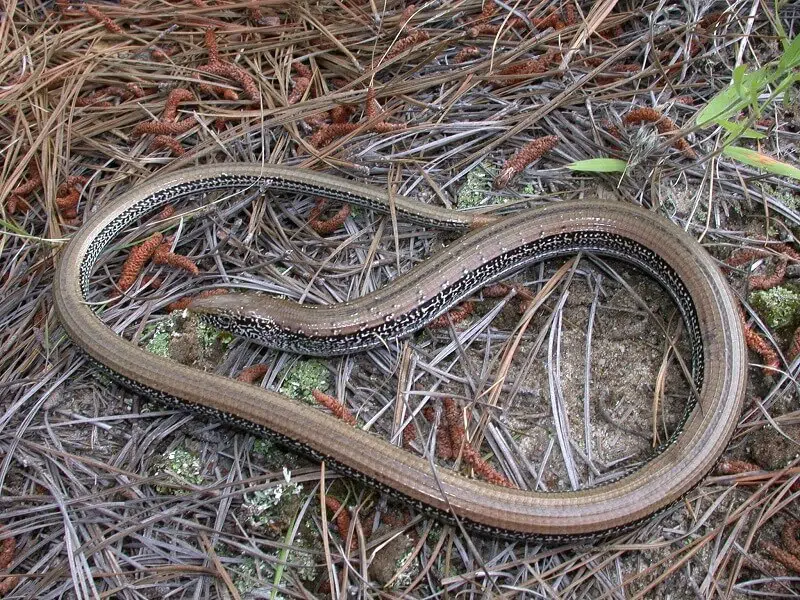
Scientific name: Ophisaurus attenuatus longicaudus.
Common Name: Eastern slender glass lizard.
This lizard is yellow to brown in color with six stripes and a middorsal stripe. They have white specks in the middle of their scales and grow to a total length of 36 inches (91cm). Their tails take up two thirds of their bodies.
These are legless lizards that are often confused as snakes, except they do have ears and eyelids. They also struggle to move across smooth surfaces, but they can move fast in their natural habitat.
They will break off a piece of their tail as captured, which continues to wiggle, keeping the predator distracted while they escape. The tail never grows back completely, so the lizard grows shorter over time.
When approached, this lizard is likely to freeze and blend in with the vegetation around it.
2. Mimic Glass Lizard

Scientific name: Ophisaurus mimicus.
Common Name: mimic glass lizard, rainbow glass lizard.
The mimic glass lizard is the smallest of the glass lizards in Mississippi.
They are brown to tan in color with pale to dark specks and a black/brown middorsal stripe with four dark stripes with spots on their lateral groove.
They grow up to 25 inches (65cm) with the male being larger than the female. Males are also more active than females.

3. Eastern Glass Lizard
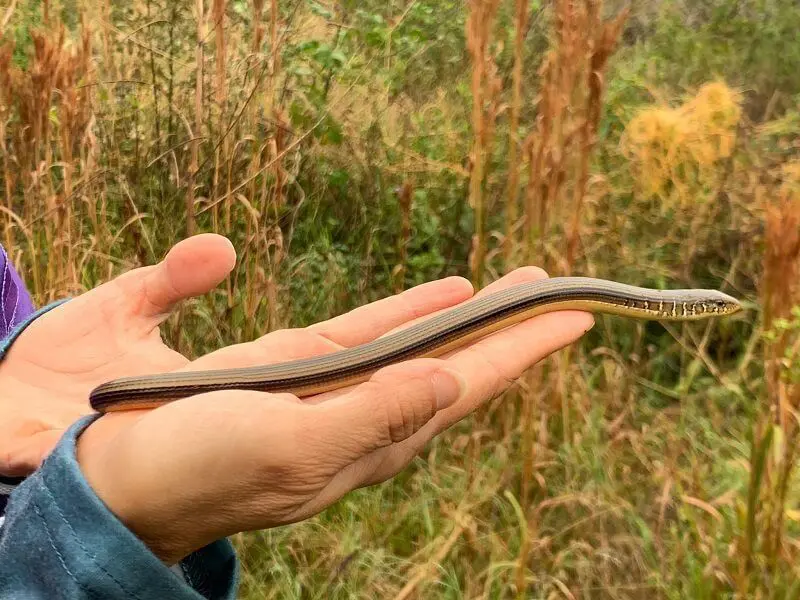
Scientific name: Ophisaurus ventralis.
Common Name: eastern glass lizard.
The Eastern glass lizard is a legless lizard that is slender and long, growing up to 43 inches (108cm) in total length with the tail taking up the majority of the body.
They have ear openings and eyelids and are considered the longest and heavier lizard in the region.
They can be brown, yellow, or green in color without the dark middorsal stripe, that you find on the other glass lizards in Mississippi. They do have some white bars behind the head.
Juveniles tend to take on a green speckled color, which fades as they age.

They enjoy a host of habitats. You can usually find them in sandy areas, flat woods, and wetlands.
The Eastern glass lizard will also break its tail when trying to escape a predator.
4. Mediterranean House Gecko

Scientific name: Hemidactylus turcicus.
Common Name: Mediterranean house gecko, Turkish gecko, moon lizard.
The Mediterranean house gecko comes from the tropical and subtropical areas of the Mediterranean and has spread throughout most of the world.
They were introduced to the United States in 1915, they are adaptable and are considered an invasive species in some states.
These geckos are easy to identify with their brown or gray bodies and pink to purple undertones with dark mottled markings.
They have bumpy skin with large eyes and grow up to 5 inches when fully grown. Their bellies are translucent and often you can see their beating heart in the right light.
These geckos also detach their tails as a defense mechanism against predators.
They thrive in warm and humid areas where there is plenty of hiding and climbing places.
They are often found in homes, where they can be seen around outside lights preying on insects attracted to the light.
5. Green Anole

Scientific name: Anolis carolinensis.
Common Name: green anole, Carolina green anole.
The green anole is considered a small to medium-sized lizard with a long-pointed head and slender body.
Males are larger than females and have a throat fan that is red and considerably larger than the dewlap of the female (by 7 times).
Females have a light color dewlap, which can range from white to very pale pink. Females also have a white stripe that runs down their backs, which the males do not have.
Males can grow to a total length of 8 inches (20cm) with their tails taking up around 70% of their length.
If you’re hoping to spot a green anole, then look in the swampy areas, forests, and treed areas. They are often seen in yards and parks, seen basking on fence posts and tree branches.
6. Brown Anole

Scientific name: Anolis sagrei.
Common Name: brown anole, Bahaman anole, De la Sagra’s anole.
Brown anoles are brown with dark brown markings on their backs, along with some lighter colored lines on the sides.
Their dewlap can be orange red to yellow in color.
Males grow to around 8 inches (20cm) in total length, females grow to around 5.9 inches (15cm) in total length.
They can live almost anywhere and are common in urban and suburban areas where there is plenty of grass, shrubs, open vegetation, or moist forest areas.
7. Northern Fence Lizard

Scientific name: Sceloporus undulatus.
Common Name: Northern fence lizard.
Northern fence lizards can grow up to 7 inches (17.8cm) in total length, including their tails.
They are tan, brown, or gray in color with dark crossbands on their backs. Adults have bright blue on their sides and tummy during the mating season.
They are fast lizards and not easy to catch.
They love the dry forested hillside habitat, but are often seen around farms and on the sides of buildings and basking in the sun on fences. They hide under tree trunks and leaf litter.
Further Reading:
8. Southern Fence Lizard

Scientific name: Sceloporus undulatus undulatus.
Common Name: Southern fence lizard.
Southern fence lizards are no stranger to homes in Mississippi.
They grow to around 7 inches and are gray with black and light gray patterns on their backs.
Their colors vary with males showing metallic blue on their throats and underside.
These lizards enjoy pine flat woods and are often seen on logs and fences, soaking up the sun. They are found on garden borders, in trees, and on porches and decks searching for food.
They are lazy eaters that do not chase their food, but rather sit in wait and then pounce on anything suitable prey that comes past.
9. Northern Coal Skink
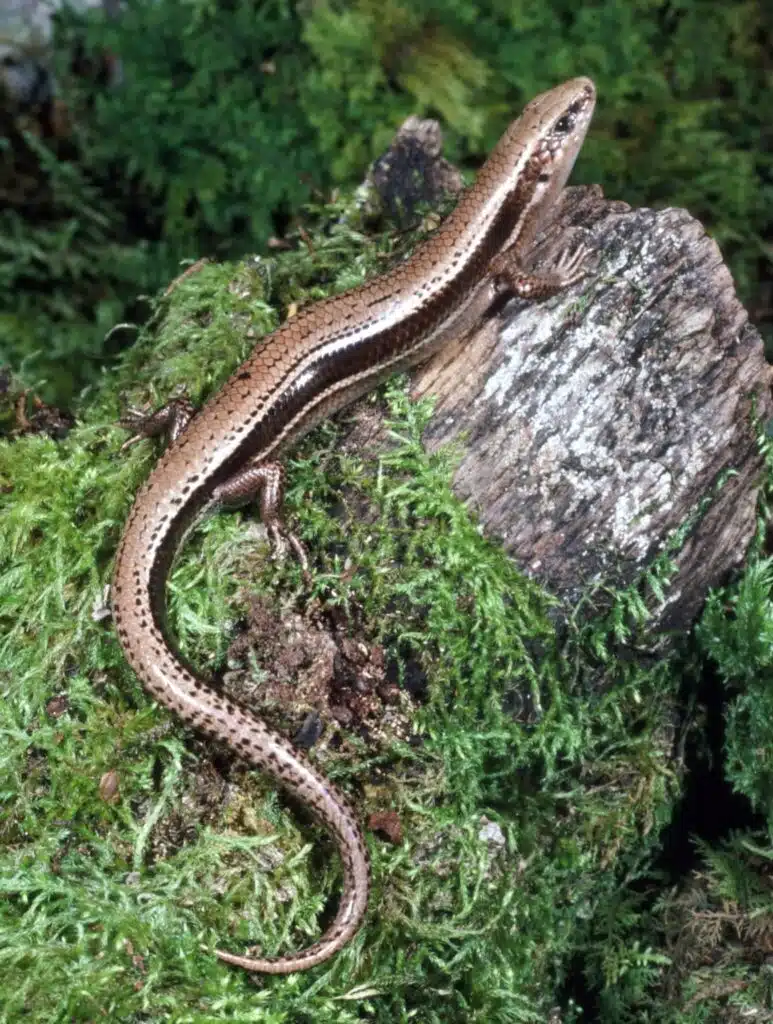
Scientific name: Plestiodon anthracinus anthracinus.
Common Name: Northern coal skink.
The Northern coal skink is a medium-sized lizard that grows to 7 inches (17cm) in total length.
They have smooth overlapping scales with a brown to tan middorsal stripe, which have light stripes. The light stripe is from the eye and onto the tail.
Males have red on the sides of their heads during mating season, in the springtime.
These skinks prefer humid areas of wooded hillsides with plenty of leaf litter and stones where they can hide. They are often found around springs and creeks and they will dive into shallow water and hide under stones or debris if pursued by a predator.
Further Reading:
10. Southern Coal Skink

Scientific name: Plestiodon anthracinus pluvialis.
Common Name: Southern coal skink.
The Southern coal skink can grow up to 7.1 inches (18cm) in total length with four light stripes that extend all the way onto the tail.
They have a broad dark lateral stripe with no lighter lines on the head.
Males have red coloration on the sides of their heads during mating season.
They prefer an abundance of leaf litter where they can hide from predators, often seen in wooded hillsides, close to springs and permanent water sources, where they will go into shallow water to hide under rocks or debris to get away from predators.
11. Common Five-Lined Skink
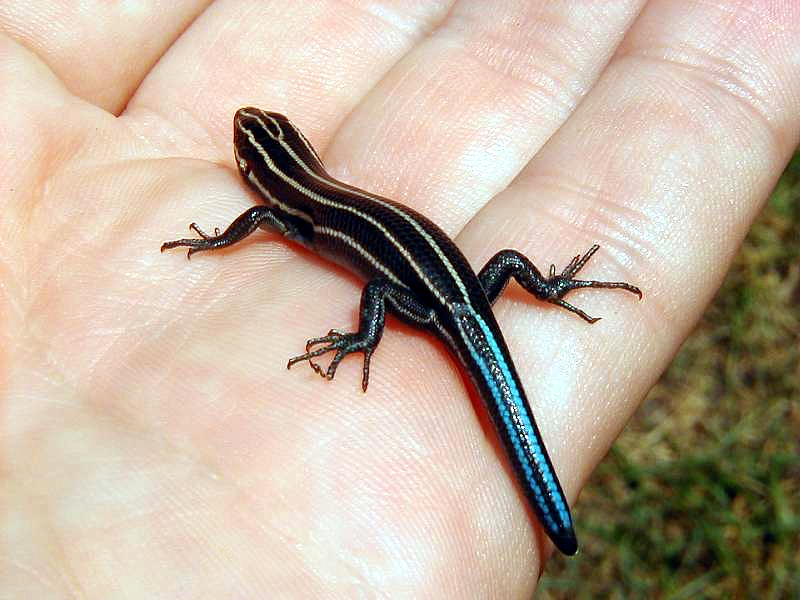
Scientific name: Plestiodon fasciatus.
Common Name: Common five-lined skink, American five-lined skink, blue-tailed skink (for juveniles), red-headed skink (for adults).
The common five-lined skink is a moderate-sized lizard with short legs and a streamlined body, growing up to 8.5 inches (21.5cm).
They are brown, black, or gray in color with five white to yellow stripes, two on either side and one down their backs.
Juveniles have a bright blue tail, which fades with age.
They will develop a red to orange color on their heads.
Futher Reading:

These lizards are as comfortable on the ground as they are in trees and will choose almost any habitat to call home from wood areas to forests and rivers.
They are easy to find by lifting a stone or log of a tree on the forest floor. They will run for the nearest tree if pursued and are not easy to catch.
They will also break off their tail if captured, giving them a chance of escape.
12. Southeastern Five-lined Skink
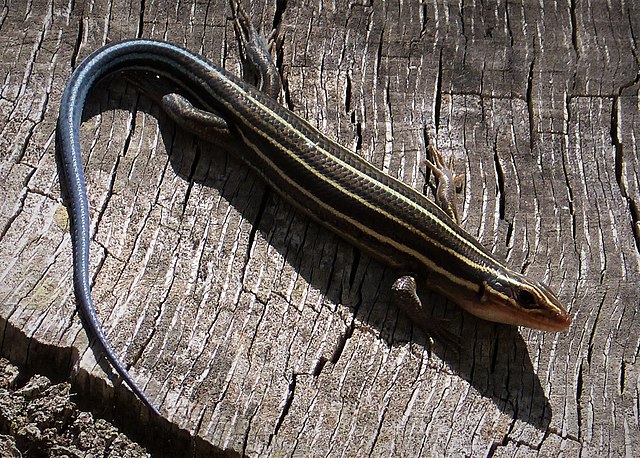
Scientific name: Plestiodon inexpectatus.
Common Name: southeastern five-lined skink.
This skink can grow up to 21 centimeters (8.5inches) in total length and is considered moderate to large sized lizards with a streamlined body and short legs.
They are black, brown, or gray in color with yellow or white stripes, two down either side and one down the length of their backs.
The same as the common five-lined skink, the juveniles have bright blue tails, which fade with age.
They are similar to the broad-headed skink with the broad-headed skink being the larger of the two.

They enjoy being on the ground and in trees and are found in dry wooded habitats where there is an abundance of leaf litter for them to hide in.
13. Broad-headed Skink

Scientific name: Plestiodon laticeps.
Common Name: broad-headed skink, broadhead skink.
Broad-headed skinks are the largest skinks in Mississippi, growing to 13 inches (33cm) in total length. They are large with streamlined bodies and short legs.
They are black, brown, or gray in color with five white to yellow stripes, two on either side and one down the back.
Adults fade to uniform brown or gray, while males develop powerful jaws and orange heads.
Juveniles have bright blue tails with prominent stripes, which fade with age.
Males are very distinctive, but females look similar to the five-lined skinks.

They prefer wooded areas and are often spotted in oak trees. The larger males spend most of their time in the trees. If pursued they will run for the nearest tree or log and they are not easy to capture.
They will break their tail when restrained, distracting their predator, while giving them a chance to escape.
14. Little Brown Skink

Scientific name: Scincella lateralis.
Common Name: little brown skink, ground skink.
The little brown skink is a slender and short lizard that grows to 5.7 inches (14cm) in total length.
They are golden brown to tan in color with dark stripes from their head to the tail. The dark stripe starts on the snout, over the eye, and all the way onto the tail.
They will break their tails to escape predators, the tail regrows a uniform brown.
Juveniles are bronze with tiny flecks of black, with more flecks closer to the tip of their tails.

You can often find little brown skinks in Mississippi under leaves and logs on the edge of woodlands and fields. They are no stranger to suburban environments, where they can be found under boards.
15. Eastern Six-lined Racerunner

Scientific name: Aspidoscelis sexlineatus sexlineatus.
Common Name: Eastern six-lined racerunner.
The Eastern six-lined racerunner can grow up to 9.5 inches (24cm) in total length. They are brown, black, or green in color with six green/yellow to yellow stripes that run from their heads to their tails.
Females have a white belly, while male bellies tend to be pale blue in color. Males also have a pale green dewlap.
Their tail is almost double the length of their body.
These are very fast-moving lizards that can reach speeds of 29 kilometers per hour when trying to escape predators.
They can be found in a range of habitats including rocky outcrops, grasslands, floodplains, and woodlands.